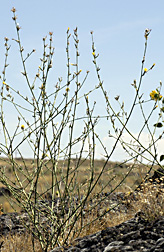This page has been archived and is being provided for reference purposes only. The page is no longer being updated, and therefore, links on the page may be invalid.
|
Read the magazine story to find out more. |
|
|
|
|
Scientists Identify North American Genotypes of Rush Skeletonweed
By Stephanie YaoJuly 30, 2009
Finding effective biocontrols against rush skeletonweed could be easier now that all genotypes of the invasive weed have been identified in North America by an Agricultural Research Service (ARS) scientist and his collaborators.
Rush skeletonweed, Chondrilla juncea, poses a threat to irrigated lands, dryland cropping areas and rangelands. It affects the cattle industry by displacing beneficial forage plant species, and its tall, wiry stems hinder the operation of crop harvest machinery. The weed also invades forests, outcompeting native plants for valuable nutrients.
The weed is mainly found in the Pacific Northwest, where it has spread rapidly during the past few decades. However, according to herbarium records, rush skeletonweed first invaded the eastern United States in the 1870s; it didn't appear in the western states until the 1930s. Since the weed is now rarely found in the eastern part of the country, scientists are unsure whether the western invasion originated from the eastern United States or overseas.
Current biocontrol agents--a gall midge, a gall mite and a rust fungus--do not appear to be effectively controlling the plant's population, in part because not all agents are effective against all genotypes of the weed.
Seeing this predicament, botanist John Gaskin, with the ARS Pest Management Research Unit in Sidney, Mont., and his colleagues from the University of Idaho and the U.S. Department of Agriculture (USDA) Forest Service's Rocky Mountain Research Station began researching the weed's genealogy in hopes of finding a solution.
The team asked county weed agencies from the United States and Canada to submit samples for DNA testing. After examining more than 700 samples, Gaskin found that only seven North American genotypes exist, five of which reside in the Pacific Northwest.
The group has also found that invasions in Australia and Argentina each contain distinct genotypes. They will be matching invasive genotypes worldwide against those found in the weed's native Eurasian range. This will help with selecting and testing new biocontrol agents and determining where to implement them.
Read more about this research in the July 2009 issue of Agricultural Research magazine.
ARS is USDA's principal intramural scientific research agency.

